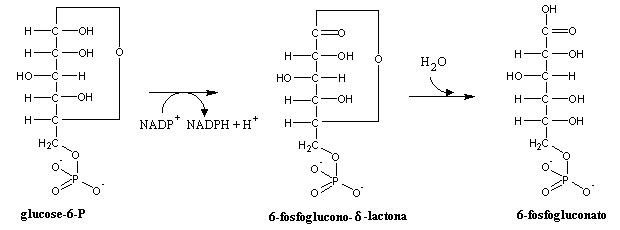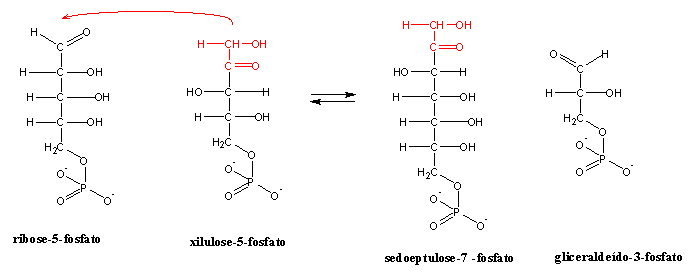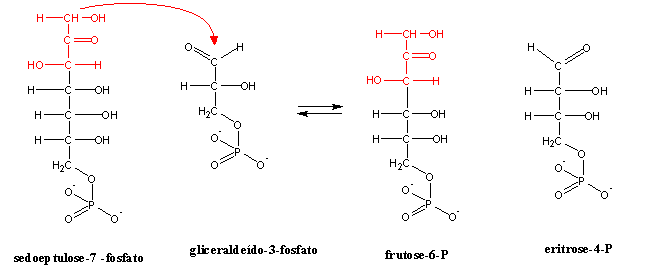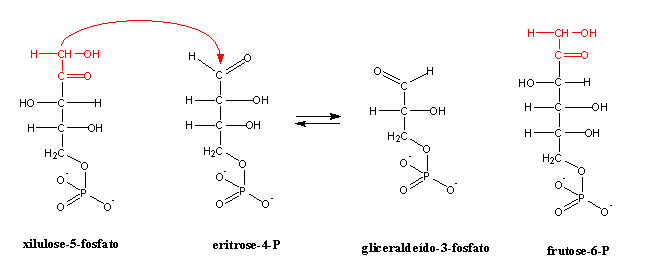Associate Professor, Universidade Fernando Pessoa
| Other metabolic pathways: |
In order to perform its anabolism, a cell needs not only energy (ATP): it also needs reducing power, under the form of NADPH. NADPH can be produced during glucose-6-P oxidation through a pathway distinct from glycolysis, the pentose-phosphate pathway. This pathway is very active in tissues involved in cholesterol and fatty acid (liver, adipose tissues, adrenal cortex, mammal glands). This pathway also produces ribose-5-P, the component sugar of nucleic acids.
Glucose-6-P's first carbon is first oxidized to a lactone (a cyclic carboxylic acid). Two electrons are released in this oxidation, and reduce one molecule of NADP+ to NADPH. The ring is then open by reacting with water:

Gluconate decarboxylation releases two more electrons, which reduce another NADP+ molecule. A five-carbon sugar, ribulose-5-phosphate, is produced in the reaction. By isomerization, ribulose-5-P is transformed in ribose-5-P. (In the figure, differences between both isomers are highlighted in green).

What will happen next depends on the needs of the cell: if its needs for NADPH outweigh those for ribose-5-P, its carbon atoms can be "recycled". This proceeds through three reactions, which form the non-oxidative part ot the pentose-phosphate pathway. In the first reaction, ribose-5-P will accept two carbon atoms from xylulose-5-P (obtained by epimerization of ribulose-5-P), yielding sedoheptulose-7-P and glyceraldehyde-3-P:

Sedoheptulose-7-P transfers three carbons to glyceraldehyde-3-P, yielding fructose-6-P and erythrose-4-P:

Erythrose-4-P then accepts two carbon atoms from a second molecule of xylulose-5-P, yielding a second molecul of fructose-6-P and a glyceraldehyde-3-P molecule:

The balance of these three reactions is:
2 xylulose-5-P + ribose-5-P -----> 2 fructose-6-P + glyceraldehyde-3-P
Fructose-6-P and glyceraldehyde-3-P can be degraded by glycolysis in orer to produce energy, or recycled through gluconeogenesis to regenerate glucose-6-P. In the latter case, through six consecutive cycles of the pentose-phosphate pathway and gluconeogenesis one glucose-6-P molecule can be completely oxidized to six CO2 molecules, with concommitant production of 12 NADPH molecules. When the demand for ribose-5-P is larger than tyhe demand for NADPH, the non-oxidative part of the pentose-phosphate pathway can operate "in reverse", yielding three ribose-5-P from two fructose-6-P and one glyceraldehyde-3-P.
 |
Biochemistry,
by Donald Voet & Judith Voet An excellent text. It presents Biochemistry with frequent references to organic chemistry and biochemical logic. Highly reccommended for students of Biochemistry, Chemistry and Pharmaceutical Sciences. |
 |
Biochemistry,
Stryer A widely used classical text, frequently updated and re-issued. |
 |
Textbook
of Biochemistry with Clinical Correlations, Thomas Devlin Strongly advised to students in Nursing, Medicine, Dentistry, etc. Plenty of examples of application of biochemical knowledge to clinical cases. |
 |
Principles
of Biochemistry, Lehninger A widely used classical text, frequently updated and re-issued. |